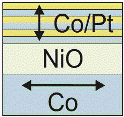Department of Physics and Astronomy: Publications and Other Research
Date of this Version
2012
Citation
Published in ACS Nano 6:11 (2012), pp 9745–9750. doi:10.1021/nn303212h
Abstract
Electric field control of magnetization is one of the promising avenues for achieving high-density energy-efficient magnetic data storage. Ferroelectric materials can be especially useful for that purpose as a source of very large switchable electric fields when interfaced with a ferromagnet. Organic ferroelectrics, such as poly(vinylidene fluoride) (PVDF), have an additional advantage of being weakly bonded to the ferromagnet, thus minimizing undesirable effects such as interface chemical modification and/or strain coupling. In this work we use first-principles density functional calculations of Co/PVDF heterostructures to demonstrate the effect of ferroelectric polarization of PVDF on the interface magnetocrystalline anisotropy that controls the magnetization orientation. We show that switching of the polarization direction alters the magnetocrystalline anisotropy energy of the adjacent Co layer by about 50%, driven by the modification of the screening charge induced by ferroelectric polarization. The effect is reduced with Co oxidation at the interface due to quenching the interface magnetization. Our results provide a new insight into the mechanism of the magnetoelectric coupling at organic ferroelectric/ferromagnet interfaces and suggest ways to achieve the desired functionality in practice.
Included in
Condensed Matter Physics Commons, Engineering Physics Commons, Materials Science and Engineering Commons, Nanoscience and Nanotechnology Commons


Comments
Copyright © 2012 American Chemical Society. Used by permission.